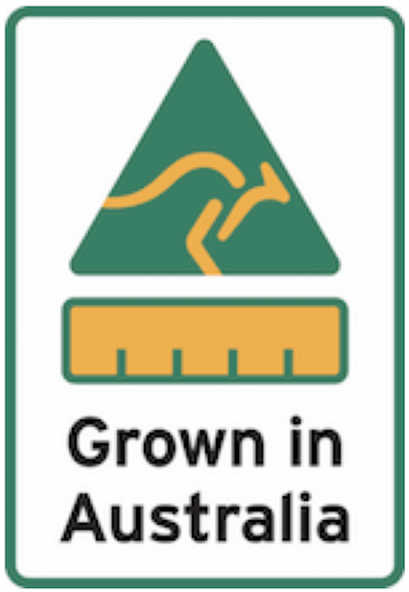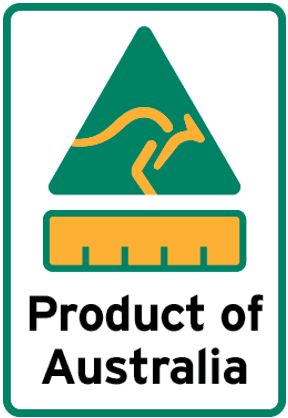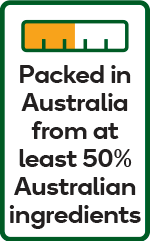Understanding country of origin labels
Mandatory seafood labels are coming
From 1 July 2026, hospitality businesses—including restaurants, cafes and pubs—will need to know and explain where the seafood they sell comes from.
Menus and signage will have to show the country of origin of dishes containing seafood that are sold for immediate consumption.
The label must use the letters A, I and M (AIM), where 'A' is for Australian, 'I' is for imported and 'M' is for mixed country of origin.
Learn more about the new seafood label requirements.
Retail food businesses need to comply with the Country of Origin Food Labelling Information Standard 2016 and display country-of-origin labels on their foods.
It's illegal for a business to make false claims about country of origin.
On this page you'll find examples (including images) of the types of food labels businesses must use.
Types of food labels
Food labels need to explain where the food is grown, produced, made or packaged.
The type of label also depends on whether the food is a 'priority' or 'non-priority' food.
Priority food labels
Priority foods include:
- fruit and vegetables
- meat, seafood and eggs
- bread and cereal (including pasta)
- milk
- nuts
- honey.
Labels on priority food grown, produced or made in Australia must include graphics and text explaining how much of the food is Australian.
The country of origin label needs to feature:
- the Australian Made, Australian Grown (AMAG) logo—a kangaroo in a triangle—to help you quickly identify the food is Australian
- a bar chart and text identifying the proportion of Australian content (if any).
Unless the product contains 100% Australian ingredients, the text must clearly show the percentage of Australian ingredients.

Non-priority food labels
Non-priority foods only need text labels (not images or graphics) about where the food was grown, produced, made or packed.
Non-priority foods belong to these categories:
- seasonings (e.g. pepper, salt, herbs, spice powders or pastes)
- confectionery (e.g. chocolate bars, lollies, ice cream)
- biscuits and snack foods (e.g. chips, crackers, rice cakes, pork crackling)
- soft drinks, sports drinks and bottled water
- alcoholic drinks
- tea and coffee.
'Grown in' labels
A ‘grown in’ label explains where the ingredients are grown. It's commonly used for fresh or multi-ingredient food.
For example, a carton of eggs that's labelled 'Grown in Australia' means the eggs came from Australian-grown chickens.

'Produced in' labels
A ‘produced in’ (or 'product of') label explains where the ingredients come from and where the food is processed.
For example, a packet of pasta labelled 'Product of Australia' means the pasta was made from scratch in Australia using only Australian ingredients.

'Made in' labels
A ‘made in’ label explains where the food was manufactured— it doesn’t mean the food only contains ingredients from the country where it was made.
For example, a loaf of bread that's labelled 'Made in Australia from at least 80% Australian ingredients' means the bread was baked in Australia and at least 80% of the ingredients are Australian.

'Packaged in' labels
A ‘packaged in’ label explains where the food has been packed—it's not necessarily grown, produced or made in any 1 country.
For example, a pack of mixed nuts labelled 'Packed in Australia from at least 50% Australian ingredients' means that at least 50% of the nuts are Australian grown.

Imported food
Imported food must also display a country-of-origin label in a clearly defined box.

Businesses can also use a shaded bar within the label if the food contains a percentage of Australian-grown or produced ingredients.

Other claims about food
Sometimes businesses add words, logos, symbols or pictures to their food packaging, implying a connection between the product and a country.
For example, a statement like ‘Proudly Australian owned’ next to an Australian flag tells you about the ownership of the company—it doesn't necessarily mean the product was grown, produced, made or packaged in Australia.
Penalties for making false claims
Failure to comply with the standard can result in enforcement action. Maximum fines are:
- $220,000 for individuals
- $1.1 million for a corporation.
More information
Consumers can:
- learn more about country of origin claims on the ACCC website
- find out more about standards businesses must meet when making country of origin claims
- make a complaint if a label doesn't comply with the law.
Businesses can:
- find out how to display the standard
- use the Australian Government's country of origin labelling tool to find out if their food needs a label and generate one
- subscribe to the Smart Business Bulletin newsletter.



